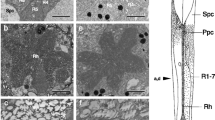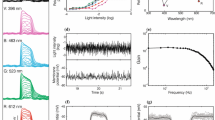Summary
The function of the facet-separating pigments in the compound eyes of the fruitfly Drosophila melanogaster with hypernormal (se), normal (+), subnormal (wa), and missing (w) pigmentation was studied by investigation of: (1) the in-flight optomotor responses to movement of striped patterns with a mean brightness of 300 cd/m2, and (2) the retinal action potentials evoked by flashes in a program of .0003 cd/m2 average brightness. The pigment deficient mutants (w a, w) are less sensitive to the pattern contrast in the bright adapted state, and more sensitive to the flash intensity in the dark adapted state than either the wild-type (+) or the overpigmented mutant(se). These differences are complementary and can be explained by the increased translucency of the pigment cells. Thus the photoreceptors in the equally illuminated eyes of the normal and mutant animals +, se, w a, and w are expected to receive light in a ratio of about 1∶1∶7∶19. However the sensitivity of the receptors as well as the half-peak widths and the density of their visual fields are apparently independent of the eye pigmentation and seem to be equal at common levels of adaptation. The effects of omnidirectional excess light reaching the receptors of the pigment deficient mutants can be simulated in less translucent eyes: when certain amounts of background illumination were combined with the optomotor stimulus in the visual fields of the wild-type receptors it was possible to elicit the predicted “mutant behavior”.
Similar content being viewed by others
Literatur
Autrum, H.: Die Belichtungspotentiale und das Sehen der Insekten. Z. vergl. Physiol. 32, 176–227 (1950); - Die spektrale Empfindlichkeit der Augenmutation whiteapricot von Calliphora erythrocephala. Biol. Zbl. 74, 515–524 (1955).
Autrum, H., I. Autrum u. C. Hoffmann: Komponenten im Retinogramm von Calliphora und ihre Abhängigkeit von der Spektralfarbe. Biol. Zbl. 80, 513–547 (1961).
Bertholf, L. M.: The extent of the spectrum for Drosophila and the distribution of stimulative efficiency in it. Z. vergl. Physiol. 18, 32–64 (1932).
Braitenberg, V. v.: Patterns of projection in the visual system of the fly. I. Retinalamina-projections. Exp. Brain Res. (im Druck).
Butenandt, A., H. Kübler u. B. Linzen: Über Ommochrome. XX. Mitt. Hoppe-Seylers Z. physiol. Chem. 319, 238–256 (1960).
Crescitelli, F., and T. L. Jahn: Electrical response of the dark adapted grasshopper eye to various intensities of illumination and to different qualities of light. J. cell. comp. Physiol, 13, 105–112 (1939).
Dethier, V. G.: The physiology of insect senses. New York: J. Wiley & Sons 1963.
Engelhardt, R.: Untersuchungen am Elektroretinogramm der Stubenfliege Musca (in Vorbereitung).
Fuortes, M. G. F.: Visual responses in Limulus eye. Pasadena: Proc, Symp. Information Processing in Sight Sensory Systems 1965.
Götz, K. G.: Optomotorische Untersuchung des visuellen Systems einiger Augenmutanten der Fruchtfliege Drosophila. Kybernetik 2, 77–92 (1964). - Verhaltensanalyse des visuellen Systems der Fruchtfliege Drosophila. Mitt. Max-Planck-Ges. 346–365 (1965a); - Die optischen Übertragungseigenschaften der Komplexaugen von Drosophila. Kybernetik 2, 215–221 (1965b); - Behavioral analysis of the visual system of the fruitfly Drosophila. Pasadena: Proc. Symp. Information Processing in Sight Sensory Systems 1965c.
Goldsmith, T. H.: The course of light and dark adaptation in the compound eye of the honey-bee. Comp. Biochem. Physiol. 10, 227–237 (1963); - Do flies have a red receptor? J. gen. Physiol. 49, 265–288 (1966).
Hagins, W. A., H. V. Zonana, and R. G. Adams: Local membrane current in the outer segments of squid photoreceptors. Nature (Lond.) 194, 844–847 (1962).
Hamdorf, K., and A. H. Kascheff: Adaptation beim Fliegenauge. Z. vergl. Physiol. 51, 67–95 (1965).
Hecht, S., and G. Wald: The visual acuity and intensity discrimination of Drosophila. J. gen. Physiol. 17, 517–547 (1934).
Kirschfeld, K.: Quantitative Beziehungen zwischen Lichtreiz und monophasischem Elektroretinogramm bei Rüsselkäfern. Z. vergl. Physiol. 44, 371–413 (1961); - Die Beziehung zwischen dem Raster der Ommatidien und dem Raster der Rhabdomere im Komplexauge von Musca. Exp. Brain Res. (im Druck).
Langer, H., u. C. Hoffmann: Elektro- und stoffwechselphysiologische Untersuchungen über den Einfluß von Ommochromen und Pteridinen auf die Funktion des Facettenauges von Calliphora erythrocephala. J. Insect Physiol. 12, 357–383 (1965).
Reichardt, W.: Quantum sensitivity of light receptors in the compound eye of the fly Musca. Cold Spr. Harb. Symp. quant. Biol. 30, 505–515 (1965).
Strother, G. K.: Absorption of Musca domestica screening pigment. J. gen. Physiol. 49, 1087–1088 (1966).
Trujillo-Cenóz, O.: Electron microscope studies on the fly eye. J. Ultrastruct. Res. (im Druck).
Viscontini, M., E. Loeser, P. Karrer u. E. Hadorn: Isolierung fluoreszierender Stoffe aus Drosophila melanogaster. Helv. chim. Acta 38, 2034 (1955).
Vowles, D. M.: The receptive fields of cells in the retina of the housefly (Musca domestica). Proc. roy. Soc. B 164, 552–576 (1966).
Washizu, Y., D. Burkhardt, and P. Streck: Visual field of single retinula cells and interommatidial inclination in the compound eye of the blowfly (Calliphora erythrocephala). Z. vergl. Physiol. 48, 413–428 (1964).
Wenking, H.: Unveröffentlicht.
Author information
Authors and Affiliations
Additional information
Der Kurvenverlauf stimmt qualitativ mit der Lichtempfindlichkeitsverteilung überein, die Washizu, Burkhardt und Streck (1964) aus den Belichtungspotentialen einzelner Sehzellen in den Rasterelementen vergleichbarer Calliphora-Rassen ermittelt haben.
Die vorliegende Arbeit ist durch die anregenden Diskussionen mit Prof. W. Reichardt sehr gefördert worden. Dipl.-Physiker H. Wenking verdanken wir die Entwicklung der Meßverstärker, Werkstattleiter H. Braun und seinen Mitarbeitern die sorgfältige Ausführung der feinmechanischen Arbeiten, Herrn E. Freiberg die Anfertigung der Abbildungen und Frl. I. Geiss die Bearbeitung des Textes.
Rights and permissions
About this article
Cite this article
Hengstenberg, R., Götz, K.G. Der Einflu\ des Schirmpigmentgehalts auf die Helligkeits- und Kontrastwahrnehmung bei Drosophila-Augenmutanten. Kybernetik 3, 276–285 (1967). https://doi.org/10.1007/BF00271510
Received:
Issue Date:
DOI: https://doi.org/10.1007/BF00271510




